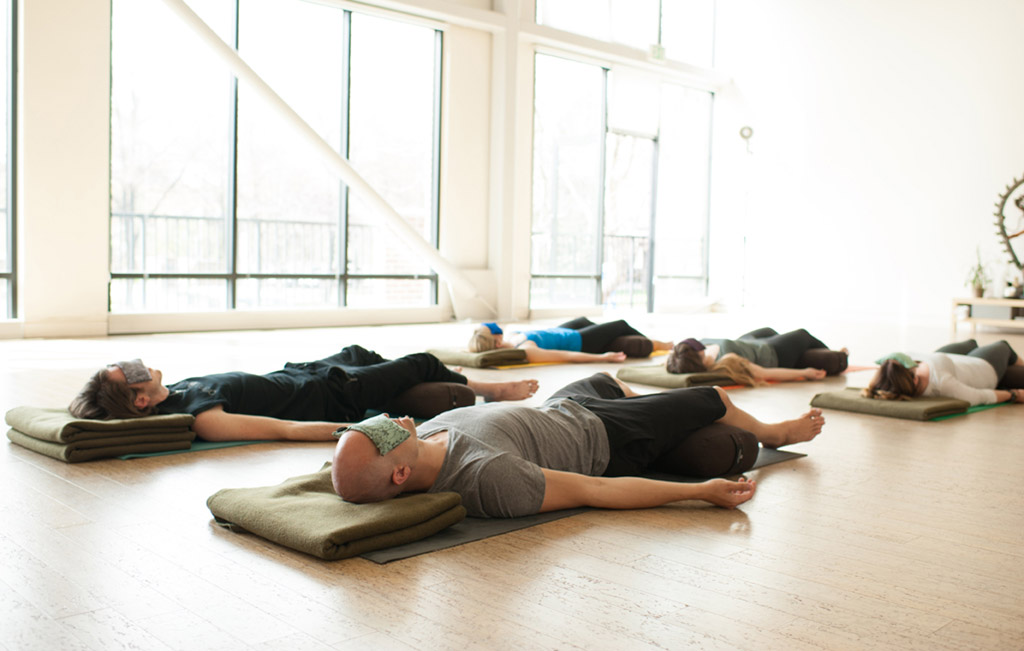
According to Celtic tradition, Samhain (the predecessor to Halloween) was a liminal time. As days in the Northern Hemisphere began to darken it was a time of ambiguity and of disorientation. Celts believed that during Samhain, the veil between life and death became more permeable. Communicating with those who have passed on became easier.
So what does this have to do with yoga? It may seem like a stretch (pun intended), but I also interpret Savasana (Corpse Pose or Final Relaxation Pose) as a pose that gives us a glimpse into the vastness of awareness. In Savasana, concerns for the body, the ego, our beliefs—all the things that we define ourselves by—can disappear. This leaves us with the essence of who we are—pure awareness.
Now of course, in Savasana, our hearts are still beating and our lungs and diaphragms are still directing the breath. But sometimes our present-moment experience can be of no boundaries, no body. Savasana provides a window into formlessness, into universal vastness and peace, our true Self. In Savasana, the boundaries between the body and the atmosphere around it disappear, while the mind stays awake and aware, settled back, observing thought bubbles and sensations from a place of spacious, non-grasping awareness.
Prepare the Ground to Lift the Veil
For most people, Savasana is yoga’s most challenging pose. Really. Sometimes the body is restless, and then there’s the mind, obsessing about some joy or injustice in the recent or distant past, or jumping ahead into whatever we’ve got planned after Savasana. When there’s little physical sensation to occupy our attention, the mind slips easily into its default mode of planning, worrying and remembering. As the body lies still, the mind is free to travel wherever it likes. And travel it does, most often to the object of stress du jour. While knowing what is catching us, even in Savasana, is helpful information for us, spinning out in the agitated mind during Savasana doesn’t necessarily set us up for a peaceful day.
5 Ways to Create a More Peaceful, Spacious Savasana
- Spend the last third of your asana practice moving slowly and practicing cooling poses such as seated, restorative or lying-down poses. Let go of striving and strain. Relax into the pose you’re practicing, no matter what it looks like.
- Make sure you have what you need to be comfortable in Savasana. This may include a yoga mat, a yoga bolster, yoga blankets and an eye pillow. Or a yoga mat may be enough. Just make sure you can be comfortable in your supine position.
- Give yourself ample time—at least 10 minutes in a practice of an hour or less and 15-20 minutes in a 90-minute practice.
- Give your “inner executive” a vacation. You need not control things. Striving for relaxation is counterproductive. Instead, just relax into whatever sensations are arising in your body. Trust your body to find equilibrium without your ego’s help.
- While you’re in Savasana, ground your awareness in your body, allowing thoughts to come and go. Let your thoughts just come and go. Here’s an image I like: Leave your front door and back door open, but don’t invite your thoughts in for tea.
According to the yoga sutras, the definition of yoga is “the settling of the mind into silence.” The silence accessible through yoga practice does not depend on external conditions. It’s a pure, unconditional awareness. Savasana allows us to lift the veil between our dualistic, ego-oriented reality and the vast silence that transcends the concepts of life and death.
